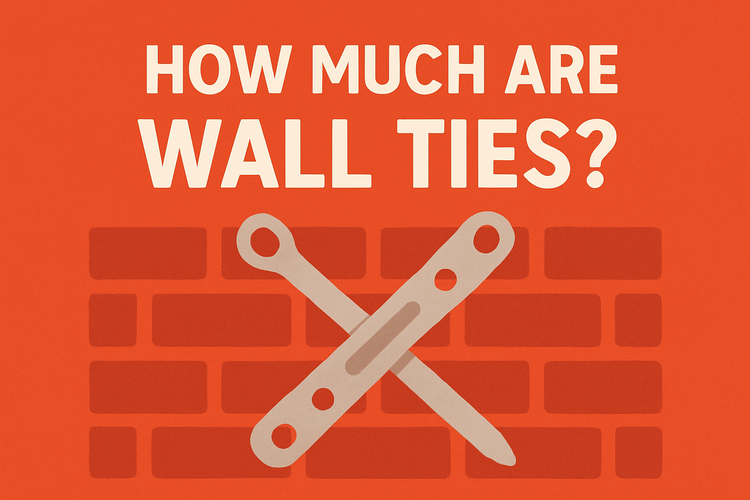How Much Are Wall Ties

What Are Wall Ties and Why Are They Essential?
Wall ties are critical components in masonry construction, designed to connect the outer and inner leaves of a cavity wall. They serve an important purpose by ensuring stability and structural integrity over time.
Made typically from stainless or galvanized steel, wall ties help in distributing loads evenly across the wall structure. They prevent issues like wall bowing and maintain the spacing between layers, essential for buildings subjected to wind and other environmental pressures. Choosing the right type of wall tie is crucial depending on the cavity width and exposure to weather elements. Regular checks during construction are also essential to confirm correct placement and compliance with building codes.
Different Types of Wall Ties and Their Applications
Wall ties come in several types, each catering to particular building requirements and environmental conditions. Understanding these types can help in selecting the most effective wall tie for your construction project.
For standard domestic construction, butterfly ties and wire ties are commonly used, offering good performance in low-rise buildings. For more demanding environments, such as coastal areas or high-rise structures, stainless steel wall ties are preferred due to their corrosion resistance. There are also cavity wall ties, designed for insulation-filled cavities, and frame cramps that connect masonry to concrete or steel frames. Each type meets specific performance standards outlined in building regulations, and selecting the right one directly influences the durability and safety of the structure.
If you're working with timber or using wall ties alongside other timber connectors, consider pairing your choice with compatible supports. For example, timber frame connectors can be used in combination to provide additional structural balance and brace capacity in hybrid constructions.
How Much Are Wall Ties?
The cost of wall ties can vary depending on the material, quantity, and intended usage. Simple galvanized steel wall ties are generally more affordable, making them ideal for basic construction needs.
On average, galvanized wall ties can cost between £0.20–£0.50 per tie when bought in bulk. Stainless steel variants, which offer superior corrosion resistance, can range from £0.50–£1.50 each, depending on specifications. Specialty wall ties intended for seismic zones or heavily insulated walls can drive the price even higher. Retailers often offer price breaks for bulk purchases, and it's not uncommon to see box sets of 250 to 500 units offered at discounted rates, which can significantly reduce cost per piece.
It’s important to factor in additional costs, such as fixings and related installation tools. If your carpentry or masonry project involves additional anchorage or reinforcement, combining wall ties with angle brackets can offer enhanced structural support while staying within budget.
Installation Considerations and Industry Standards
Correct installation of wall ties is crucial for their effectiveness. Poor placement can compromise structural integrity and potentially lead to expensive remediation.
Wall ties should be installed at regular vertical and horizontal intervals, typically 450mm vertically and 900mm horizontally across masonry panels. Special attention should be given to corners, openings, and firebreaks, where spacing may need to be increased. Best practice also involves embedding each end of the tie at least 50mm into the mortar bed and ensuring a slight downward slope to drain moisture. British Standards such as BS EN 845-1 and PD 6697 outline these exact requirements, and compliance ensures longevity and structural assurance.
Installers should also consider environmental challenges. In areas exposed to high winds, combining wall ties with high wind ties and timber connectors provides additional resistance against lateral movement. Correct tie selection and diligent installation play a vital role in the overall performance of load-bearing designs.
Maintaining and Replacing Wall Ties in Older Properties
Over time, wall ties in older buildings may corrode or fail, especially if made from mild steel and exposed to moisture. Recognizing the signs early can prevent structural issues down the line.
Tell-tale signs of failing wall ties include bulging walls, horizontal cracks in the mortar joints, and internal dampness. These indicators suggest wall ties have corroded or were improperly fixed. In such cases, a wall tie survey using metal detectors and borescopes is advisable. Replacing them promptly involves inserting new ties and isolating the old ones to prevent further damage. Modern stainless steel replacement wall ties are designed for retrofit and meet today's durability standards.
Upgrading wall tie systems can also be an opportunity to incorporate other structural support mechanisms. For instance, properties that require reinforcement due to remodeling or load-bearing changes might benefit from additional support elements available through masonry connectors and wall ties. This helps futureproof your structure according to modern building codes and environmental challenges.
